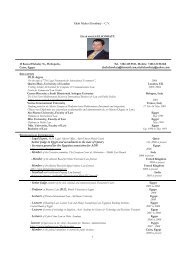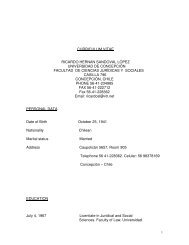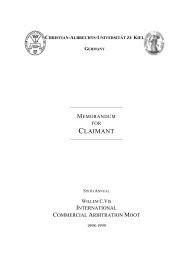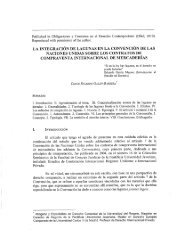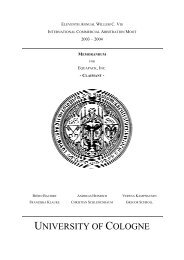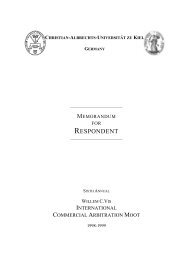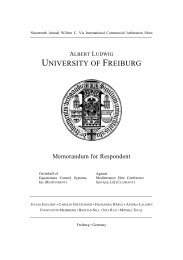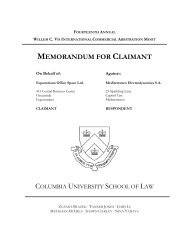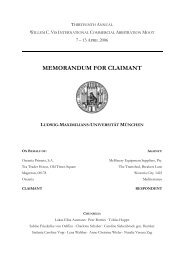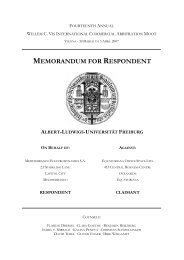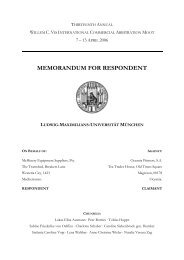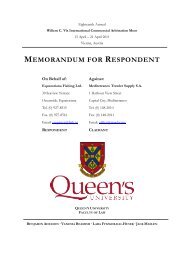Equapack, Inc. v. Medi-Machines S.A. Memorandum for Medi ...
Equapack, Inc. v. Medi-Machines S.A. Memorandum for Medi ...
Equapack, Inc. v. Medi-Machines S.A. Memorandum for Medi ...
Create successful ePaper yourself
Turn your PDF publications into a flip-book with our unique Google optimized e-Paper software.
declaration of avoidance. [Date-Bah 223-225; Enderlein/Maskow 116-117; Jacobs 409, 428;<br />
Huber 425; Leser 188-189; Romito/Sant’Elia 200]. The German case to which CLAIMANT<br />
refers, [see <strong>Memorandum</strong> <strong>for</strong> Claimant 56], is in fact an application of the general rule that<br />
indirect notice of avoidance is inadequate. [AG Zweibrücken, 14 Oct. 1992 (Germany); see also<br />
LG Frankfurt, 16 Sept. 1991 (Germany)]. Exceptions to this rule have only been made in<br />
extreme circumstances, which are not present here. [See, e.g., Roder v. Rosedown Park<br />
(Australia); OLG Hamburg, 28 Feb. 1997 (Germany)].<br />
68. Indeed, the case to which CLAIMANT refers presents a factual situation indistinguishable in<br />
material respects from the current case. The German court specifically held that a complaint<br />
about the goods coupled with a suggestion that the buyer take back the goods was inadequate<br />
notice of avoidance. [AG Zweibrücken, 14 Oct. 1992 (Germany)]. Similarly, CLAIMANT<br />
bases its claim of avoidance on Mr. Swan’s written statement that CLAIMANT no longer<br />
wanted the machines and that RESPONDENT could dispose of them at will. [Claimant’s Ex. 6;<br />
<strong>Memorandum</strong> <strong>for</strong> Claimant 59]. Following the reasoning of the German case, there is no<br />
question that the purported notice of avoidance given by CLAIMANT was inadequate.<br />
2. CLAIMANT’s purported declaration of avoidance was not timely.<br />
69. If a valid declaration of avoidance is not made within a reasonable time after the buyer knew<br />
or ought to have known of the breach, right to avoid lapses. [Art. 49(2)(b)(i) CISG; Leser 189].<br />
Where the defect is hidden, courts limit the concept of a “reasonable time” to a few days after the<br />
breach did or ought to have become apparent. [LG Ellwangen, 21 Aug. 1995 (Germany)]. If the<br />
buyer delays <strong>for</strong> longer, its declaration will be untimely and there<strong>for</strong>e ineffective. [HG Zürich,<br />
26 Apr. 1995 (Switzerland)]. Even if the Tribunal determines that RESPONDENT knew of a<br />
defect in the product, CLAIMANT is still required to make a declaration of avoidance within<br />
“reasonable time” in order to retain the right to avoid. [Honnold (2) 333].<br />
70. Here, CLAIMANT’s purported declaration of avoidance was not made within a reasonable<br />
time. Where defects should have been immediately apparent or were discernible from a simple<br />
inspection, the “reasonable time” will begin to run from the time that the buyer is obligated to<br />
carry out a reasonable inspection. [Art. 39 CISG; Honnold (2) 331]. As discussed above, [see<br />
supra 63-64], any defects in the Model 14 machines should have been immediately obvious<br />
to CLAIMANT upon undertaking the required inspection. Even CLAIMANT admits that it<br />
23



